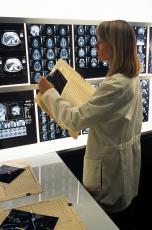 |
 |
 |
Other Health Topics:

-
Related Topics
-
Go Local
- Services and providers for Diagnostic Imaging in the U.S.
-
National Institutes of Health
- The primary NIH organization for research on Diagnostic Imaging is the National Institute of Biomedical Engineering and Bioimaging
Diagnostic imaging refers to technologies that doctors use to look inside your body for clues about a medical condition. A variety of machines and techniques can create pictures of the structures and activities inside your body. The technology your doctor uses will depend on your symptoms and the part of your body being examined. X-rays, CT scans, nuclear medicine scans, MRI scans and ultrasound are all types of diagnostic imaging.
Many imaging tests are painless and easy. Some require you to stay still for a long time inside a machine, though. This can be uncomfortable. Certain tests involve radiation, but these are generally considered safe because the dosage is very low.
For some imaging tests, a tiny camera attached to a long, thin tube is inserted in your body. This tool is called a scope. The doctor moves it through a body passageway or opening to see inside a particular organ, such as your heart, lungs or colon. These procedures often require anesthesia.
| Basics | Learn More | Multimedia & Cool Tools |
|---|---|---|
|
||
| Research | Reference Shelf | For You |
-
Overviews
-
Diagnostic Imaging
 (National Institutes of Health)
(National Institutes of Health)
- X-rays, CT Scans and MRIs(American Academy of Orthopaedic Surgeons)
-
Diagnostic Imaging
-
Latest News
- Imaging System Lets Doctors 'See' Cancer During Surgery(08/19/2008, HealthDay)
- Experimental Imaging System Helps Detect Breast Cancer(06/26/2008, HealthDay)
-
Specific Conditions
- Needle Biopsy(Mayo Foundation for Medical Education and Research)
- Video-Assisted Thoracic Surgery (VATS)(Harvard Medical School)
-
Related Issues
- Doses from Medical Radiation Sources(Health Physics Society)
- Important Questions to Ask about the Quality of Your Imaging Examination(American College of Radiology)
-
Radiation Exposure in X-Ray Examinations(American College of Radiology, Radiological Society of North America)
Also available in Spanish
-
What You Need to Know about Contrast Agents(American Society of Radiologic Technologists) - Links to PDF
Also available in Spanish
-
What You Need to Know about Tracing the X-Ray Trail(American Society of Radiologic Technologists) - Links to PDF
Also available in Spanish
-
Research
-
Optical Imaging
 (National Institutes of Health) - Links to PDF
(National Institutes of Health) - Links to PDF
-
Point-of-Care Diagnostic Testing
 (National Institutes of Health) - Links to PDF
(National Institutes of Health) - Links to PDF
-
Optical Imaging
-
Journal Articles
References and abstracts from MEDLINE/PubMed (National Library of Medicine)
- Article: Trichoscopy.
- Article: Laser capture microscope: an innovative tool for single cell dissection.
- Article: Cardiac optical coherence tomography.
- Diagnostic Imaging -- see more articles
-
Dictionaries/Glossaries
-
RadiologyInfo: Glossary of Terms(American College of Radiology, Radiological Society of North America)
Also available in Spanish
-
RadiologyInfo: Glossary of Terms(American College of Radiology, Radiological Society of North America)
-
Directories
- American College of Radiology Accredited Facility Search(American College of Radiology)
-
Organizations
- Center for Devices and Radiological Health
- RadiologyInfo(American College of Radiology, Radiological Society of North America)
-
Children
-
Keeping Kids Still during Exams(American Society of Radiologic Technologists)
Also available in Spanish
- Radiology and Children: Extra Care Required(Food and Drug Administration)
-
Keeping Kids Still during Exams(American Society of Radiologic Technologists)
| Home | Health Topics | Drugs & Supplements | Encyclopedia | Dictionary | News | Directories | Other Resources | |
| Copyright | Privacy | Accessibility | Quality Guidelines U.S. National Library of Medicine, 8600 Rockville Pike, Bethesda, MD 20894 National Institutes of Health | Department of Health & Human Services |
Date last updated: 27 August 2008 Topic last reviewed: 21 August 2008 |






